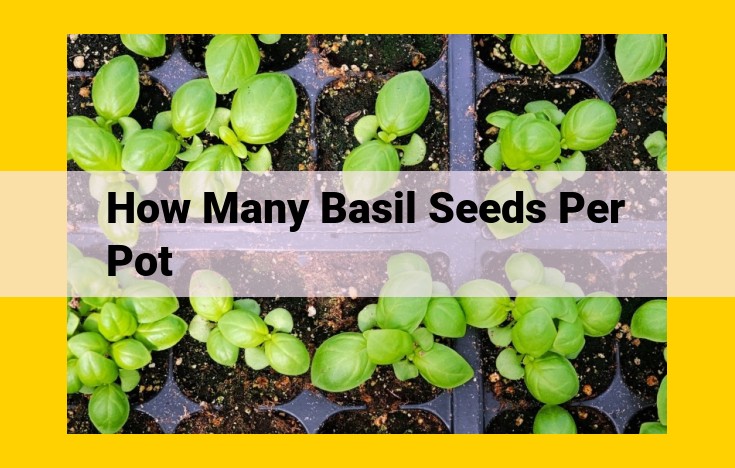- Optimal planting conditions are crucial for basil growth. Selecting the right pot size and spacing ensures proper root development and airflow. The soil should be well-drained and contain organic matter. Basil prefers full sun but can tolerate partial shade. Temperature should range between 65-85°F for optimal germination and growth.
Basil Seed Selection and Quality: A Crucial Foundation for Culinary Excellence
Embarking on the aromatic journey of growing your own basil requires a meticulous approach, starting with the selection of high-quality seeds. Premium seeds lay the groundwork for thriving basil plants that will generously reward you with an abundance of flavorful leaves.
When choosing basil seeds, viability, germination rate, and freshness are paramount considerations. Viable seeds are those capable of germinating and developing into healthy plants, while a high germination rate indicates the number of seeds that will successfully sprout. Fresh seeds, harvested recently, boast superior vigor and yield compared to older ones.
These factors collectively determine the success of your basil-growing endeavor. Investing in quality seeds ensures a strong foundation for vibrant plants that will gratify your culinary senses for seasons to come.
Choosing the Right Pot Size and Spacing for Optimal Basil Growth
When selecting containers for your basil plants, it’s important to choose pots that are large enough to accommodate their root systems. Aim for a pot diameter of at least 6 inches for single plants or 8 inches for multiple plants. The holes in the pot bottom should also be adequate to allow excess water to drain.
Spacing between basil plants is equally important for air circulation and disease prevention. When planting in containers, leave at least 6 inches between each plant. Overcrowding can lead to stunted growth, poor flavor development, and an increased risk of fungal diseases.
Determining the Appropriate Soil Type, Seed Depth, and Light Requirements for Basil
Basil thrives in well-drained, fertile soil. Use a potting mix that is specifically designed for herbs or create your own blend by combining equal parts peat moss, compost, and perlite.
When planting basil seeds, sow them 1/4 inch deep into the soil. Keep the soil moist but not soggy, and place the seeds in a warm, sunny location. Basil plants typically require at least 6 hours of sunlight per day for optimal growth. If necessary, use grow lights to supplement natural sunlight.
Managing Temperature Range for Optimal Basil Growth
Basil is a warm-season herb that prefers temperatures between 65°F and 85°F. When temperatures drop below 50°F, basil plants may become dormant or even die. Protect your plants from cold temperatures by bringing them indoors or covering them with a plastic cloche.
On the other hand, excessive heat can also be detrimental to basil. If temperatures exceed 95°F, the leaves may scorch and the plant may wilt. To prevent overheating, provide shade for your basil plants during the hottest part of the day.
Cultivation Techniques for Bountiful Basil
Watering Wisdom:
Nurturing healthy basil plants demands a precise watering regimen that harmonizes with soil conditions. This aromatic herb craves consistently moist soil, yet shudders at the thought of soggy roots. Monitor moisture levels diligently and water deeply when the soil feels slightly dry to the touch. This delicate balance ensures optimal growth without succumbing to root rot.
Harvesting the Essence:
Timing is everything when it comes to harvesting basil. Snip the leaves just before the plant flowers to capture the peak of flavor and aroma. These tender leaves are brimming with essential oils that endow basil with its distinctive character. By harvesting regularly, you encourage continuous growth and productivity, ensuring a steady supply of this culinary treasure.
Basil Yield and Quality
- Measuring and optimizing basil yield through proper cultivation practices
- Factors influencing basil quality, such as taste, aroma, and visual appearance
Basil Yield and Quality: Cultivating Culinary Perfection
In the realm of herbs, basil stands out as an aromatic delight that enhances countless dishes. But for those aspiring basil enthusiasts, achieving optimal yield and quality requires a nuanced understanding of cultivation practices and the factors that influence this beloved herb.
Measuring and Optimizing Basil Yield
To ensure a bountiful harvest, proper cultivation techniques are paramount. Regular watering is essential, but be mindful to avoid overwatering, which can lead to root rot. Monitoring soil moisture levels will guide your watering schedule.
Harvesting at the peak of maturity is crucial for maximizing basil yield. This generally occurs when the plants have developed 6-8 sets of true leaves. Delaying harvest may result in decreased flavor and aroma.
Factors Influencing Basil Quality
Beyond yield, the quality of your basil is of utmost importance. Several factors contribute to its distinctive characteristics:
- Taste: The delicate interplay of volatile compounds and essential oils creates basil’s unique flavor profile.
- Aroma: The release of aromatic compounds upon bruising or crushing enhances basil’s sensory appeal.
- Visual Appearance: Healthy, lush leaves contribute to basil’s visual beauty, making it an attractive addition to any culinary presentation.
By carefully attending to these factors, you can cultivate basil that delights the senses and elevates your culinary creations. Whether you prefer the classic Italian varieties or the aromatic Thai basil, the rewards of successful basil cultivation will undoubtedly enhance your culinary adventures.
